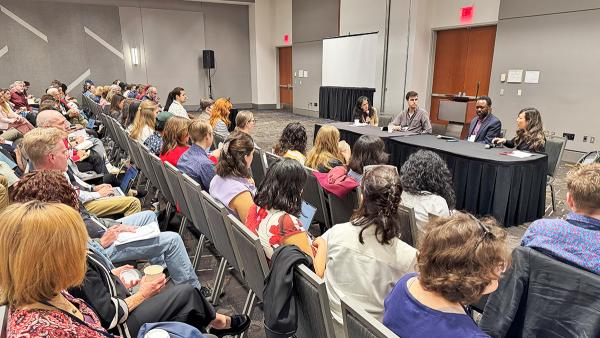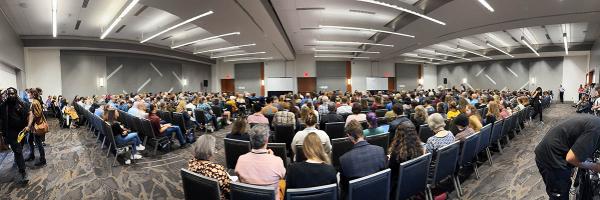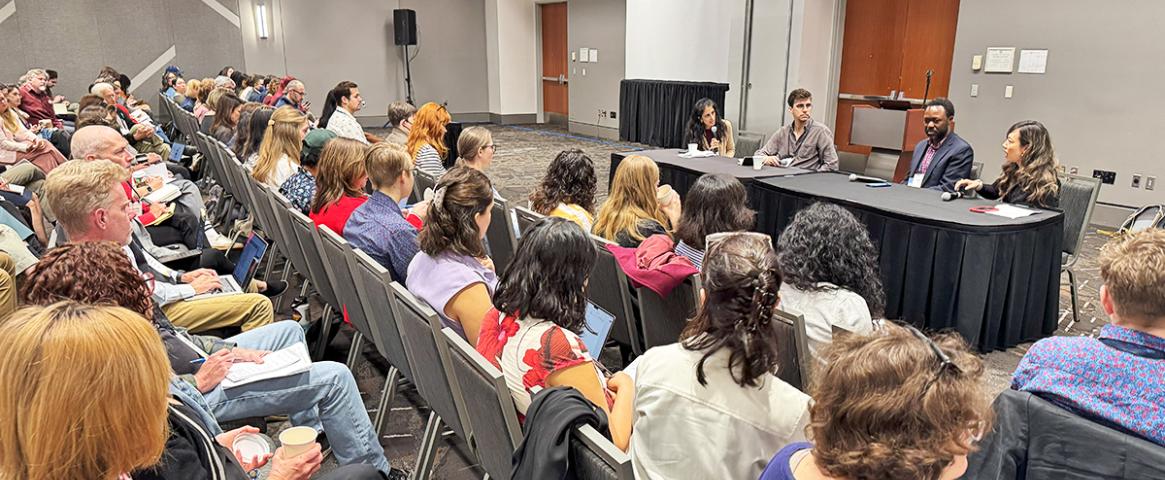Story by Ambika Kandasamy
You’ve interviewed multiple sources, read through numerous research papers and documents and gathered the material you need to begin crafting your science story. It is now time to write. What are some questions to consider when constructing your story? How do you strike a balance between explaining a complex scientific concept and telling a good story? What kinds of societal power dynamics should you be aware of when structuring your piece?
These craft-and-technique questions commonly faced by science writing professionals were among those addressed in the "Building Your Story’s Structure" NASW workshop at the ScienceWriters2024 national conference in Raleigh, N.C., in November. The conversation was moderated by Maya L. Kapoor, a freelance journalist who covers climate change, biodiversity, and environmental justice.
Kapoor kicked off the discussion by asking a panel of writers and editors about how they think about story structure.
John Thomason, features editor at Grist, said his approach tends to be collaborative rather than prescriptive. Some questions he considers when structuring a story are: “What is it that the writer and I are trying to deliver?” and “What are we withholding from the reader and why are we withholding it?”
When contemplating story structure, Ashley Smart, associate director of the Knight Science Journalism Program at the Massachusetts Institute of Technology, said two questions that serve as his north stars are “How do I keep this piece interesting?” and “How do I keep it clear and easy to follow?”
Erika Hayasaki, professor of literary journalism and independent journalist, said she conceptualizes it in three dimensions: the first is the character dimension, which could be a person, place or thing that moves through time; the second is the social dimension, which focuses on why the story is being covered now and the third is the human condition dimension, which explores existential questions.

Moderator Maya L. Kapoor listens to Erika Hayasaki speak on the session panel at ScienceWriters2024. (Ben Young Landis/NASW)
The discussion also touched upon how to convey complex science in narrative form.
Smart said science writers can sometimes be taken by the “coolness of the science,” and his philosophy is to explain only as much as is needed for the reader to understand the story. He added that while it could be tempting to include a huge amount of explanatory material early in the story, it can be more effective to tuck it in places where the reader can follow along easily.
All three panelists pointed to examples of stories they have written or edited to help illustrate their perspectives.
Thomason gave a rundown of developing an investigative story by freelance journalist Austyn Gaffney. The story was about an indoor farming company’s treatment of its workers and its eventual demise. He said they landed on leading with Sen. Mitch McConnell’s visit to the company’s premises and that became resonant with the themes in the story of how the company became something akin to political football instead of a worker-centered project.
Hayasaki described a story she wrote about the use of rapid DNA analysis in identifying victims of deadly wildfires. She pointed to a checklist she finds helpful called the “Power Narrative Edit” by Sandhya Dirks, a national correspondent at NPR who covers race and identity.
She said Dirks’ resource includes questions like whose voice and language are being used and centered. Hayasaki said for her story, she practiced trauma-informed journalism, which has its own rules for interviewing survivors, including walking them through how the story could come out in the world.
- Read Erika Hayasaki’s tipsheet from this conference session (Substack)
And Smart discussed an opinion piece by epidemiologist Nina Harawa for Undark about the drop in life expectancy of Black men in the U.S., which she pitched during the COVID-19 pandemic. Quoting the story’s opening line, “The only widows I knew in college were Black women who had married Black men,” Smart said: “Immediately, we’re kind of in her shoes, feeling a sense of loss with her.” He said that the opening line had been buried further down in initial drafts but was brought to the top of the piece later.
When asked about bringing personal and subject matter expertise to a story, Smart said, “I think it worked well in that piece because she put herself into the story with a lot of purpose.”

A packed conference hall listens to the panel on building story structure at ScienceWriters2024 in Raleigh. (Ben Young Landis/NASW)
Ambika Kandasamy (linkedin.com/in/ambikakandasamy) is a journalist interested in covering health and environmental stories. She has worked at FRONTLINE (PBS), Shareable, GlobalPost and other organizations and has written for National Wildlife magazine, San Francisco Public Press, Bay Nature and other outlets.
This ScienceWriters2024 conference coverage article was produced as part of the NASW Conference Support Grant awarded to Kandasamy to attend the ScienceWriters2024 national conference. Find more 2024 conference coverage at www.nasw.org
A co-production of the National Association of Science Writers (NASW), the Council for the Advancement of Science Writing (CASW), and the Science Communicators of North Carolina (SCONC), the ScienceWriters2024 national conference featured an online portion Oct. 16-18, followed by an in-person portion held in Raleigh, N.C., Nov. 8-11. Follow the conversation via #SciWri24 on Bluesky and on LinkedIn.
Founded in 1934 with a mission to fight for the free flow of science news, NASW is an organization of ~2,400 professional journalists, authors, editors, producers, public information officers, students and people who write and produce material intended to inform the public about science, health, engineering, and technology. To learn more, visit www.nasw.org and follow NASW on LinkedIn and Bluesky. And join us in celebrating #NASW90th.
Credits: Reporting by Ambika Kandasamy; edited by Ben Young Landis.


